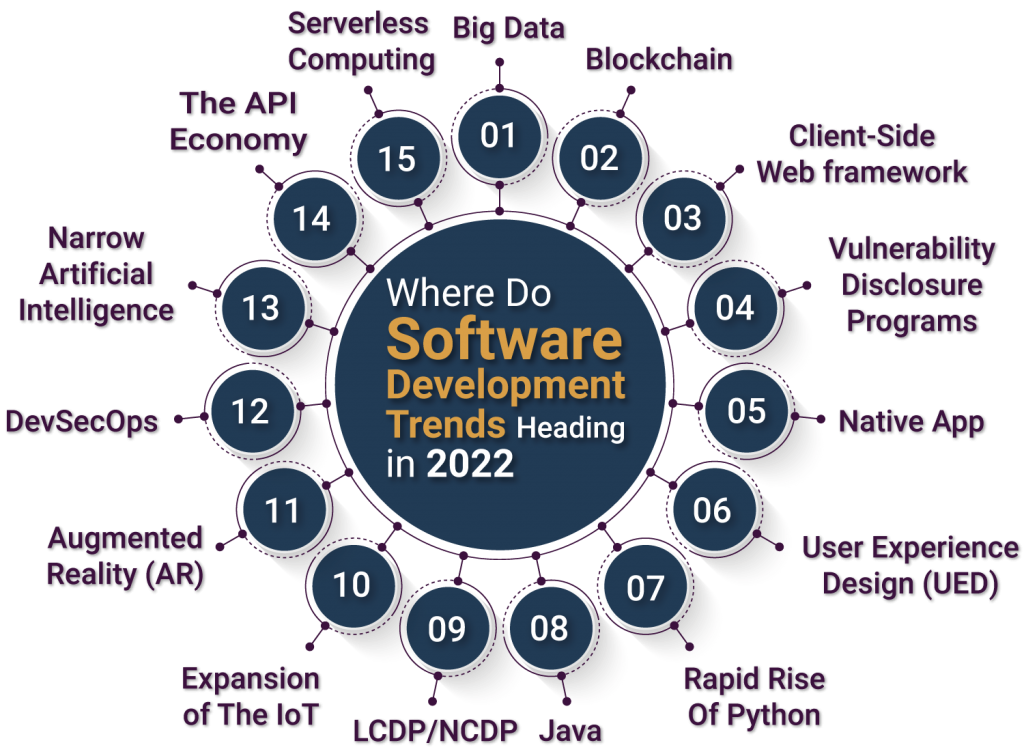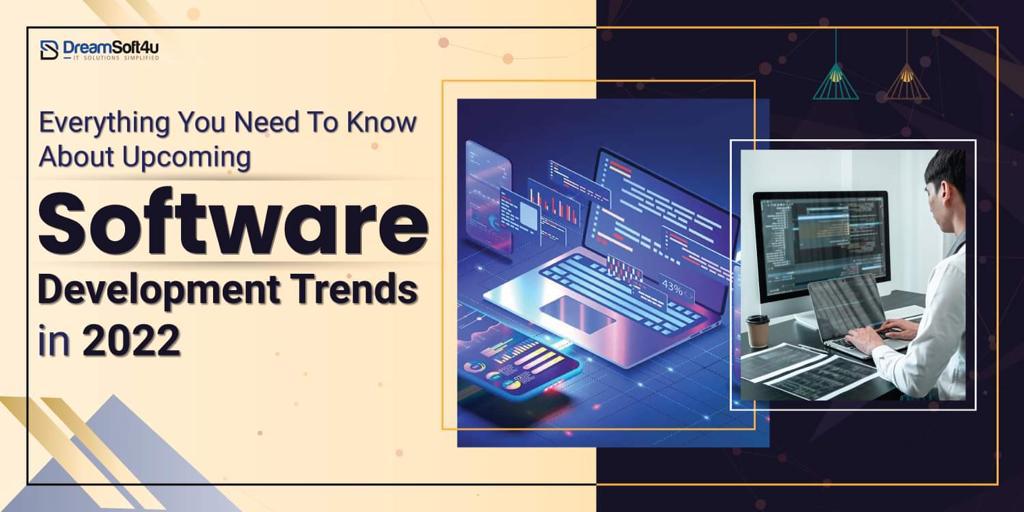Software development service is a new wave that is ever-evolving. In the previous years, too much transformation has happened in digital infrastructure. Especially, in the pandemic years, digital infrastructure has been renovated at its full pace. Human beings being trapped in their places have wholeheartedly welcomed digital services.
Not only this, but a custom software development company has also upscaled the economy by producing many customized businesses. We are witnesses of a situation where the web can provide from PPE to virtual weddings. It is all done through great software development. Over the past few years, businesses have accelerated their services and technology development to provide user-friendly software and increase competition in the market.
In 2022, many trends in software development have been introduced, and many more are about to come. Let’s see the upcoming software development trends in 2022.
Where Do Software Development Trends Heading in 2022?
Software development is developing systems for organizations or businesses. It boosts their work-flows, and efficiency, and maintains swift growth in the market. The trends have definitely turned the tables for many custom software development companies that were earlier trying to gain business momentum. Therefore, we have shared a list of top trends in software development in 2022. Read all the details and adopt as many trends as per your business convenience.

1. LCDP/NCDP
LCDP is known as a Low-code development platform, and NCDP is known as a No-code development platform. It provides pre-built blocks that can be dropped and dragged by professional developers to help in the rapid development of mobile and web apps. Appian, Outsystems, and Mendix are the popular platforms for LCDP and NCDP.
2. User Experience Design (UED)
The process of enhancing user satisfaction with a software product is called UXD or UED. It stands for User Experience Design. The technology improves the accessibility, pleasure, and usability of each point. It deploys the products after understanding the problems of users. UED tries to meet the expectations of users.
3. DevSecOps
DevSecOps stands for Development, Security, and Operations. It is responsible for implanting security at every stage of the DevOps pipeline. Organizations make security as their topmost priority due to the growing threats. Now, organizations have begun to shift toward DevSecOps because it offers to implant security in each stage of development.
4. The API Economy
It is responsible for achieving integration across service and data by using APIs. The organizations have access to new services and products without building them themselves. It includes microservices, omnichannel retailing, and event-driven architecture.
5. Vulnerability Disclosure Programs
These programs are responsible for disclosing, handling, and reporting against threats following ISO standards. It creates a secure channel for security issues and vulnerability. It protects whistleblowers. Where organizations and government agencies focus on cybersecurity, these programs help the organization to become proactive against threats.
6. Serverless Computing
Serverless Computing leverages building apps without hosting or maintaining the server by managing cloud infrastructure. These are the following examples of serverless Computing- Microsoft Azure Functions, IBM OpenWhisk, AWS Lambda, and Google cloud functions.
7. Big Data
Big data is a field that works by using advanced techniques with complex or large sets of structured and unstructured data. Examples of big data are Customer databases, Medical records, Documents, Emails, Internet clickstream logs, Transaction processing systems, Social networks, and mobile apps.
It is divided into three parts. They are- Structured Data, Unstructured Data, and Semi-structured Data. It is a set of technologies created to analyze, manage, and store this bulk data. It is used by private organizations, government, and individuals in intelligent transport systems, traffic control, congestion management, route planning, etc.
8. Augmented Reality (AR)
It is a technology that shows us the enhanced version of the real physical world. It uses digital visual elements, sensors, and sound. It is different from VR. VR replaces a real-life environment with a simulated one. It is used by retailers and companies to launch novel marketing campaigns, promote products and services, collect unique data, etc. Companies like Zara, Ikea, Kendra Scott, Shopify, and much more use this technology. There is a rumor that Apple is going to release AR/VR headsets in 2022.
9. Expansion of the IoT
IoT means the Internet of Things. It is a collective network of connected devices. It offers communication between devices and the cloud. It has limitless potential in the future. It will exchange and collect data in real-time. Appliances like cars, television, refrigerator, lights, AC, etc. can be connected to the IoT. The trend has revolutionized the way houses were built earlier. Not only this, it has made human home decor smarter. From opening the door to voice assistance and whatnot, IoT is expected to be the most revolutionary trend.
10. Blockchain
A blockchain is a chain of the block that contains information in a way that it is impossible to cheat, hack, or change a system. In other words, we can say that it is a foundation for records of transactions or immutable ledgers that can not be destroyed, altered, or deleted. Walmart, J.P Morgan, Amazon, Nvidia, Microsoft, PayPal, Samsung, the Bank of China, and Alibaba are among 27 companies that use Blockchain.
11. Narrow Artificial Intelligence
Narrow Artificial Intelligence is an AI system that is used to handle a singular or limited task. It is also known as weak AI. In the past decade, this technology has achieved massive growth and adoption like Machine learning and Deep learning. There will be more funding, adoption, and adoption in 2022.
12. Rapid Rise of Python
Python has experienced a rapid rise as a general-purpose programming language in recent years. Presently, it is in number one rank in programming language according to a popular programming language ranking website TIBOE.
If you are a beginner or willing to learn the programming language, you should start with Python. There are many more programming languages apart from Python. Here are some suggestions which are best for the following development-
- Web Development- JavaScript, TypeScript
- System Programming- Rust,C,C++, Golang
- iOS Development- Swift
- Android Development- Kotlin
- Backend Development- Golang, JavaScript, TypeScript,Java
- Data Engineering/Data Science- Python
13. Java
Now, Python holds number one ranking on the popular programming language ranking website TIBOE, and Java at 3rd position in the ranking. But for a long time, Java was ranked one on the programming language ranking website TIBOE. It is a powerful, multi-threaded, interpreted, garbage-collected, and moderately complex programming language. It is ideal for large, monolithic enterprise applications.
Java will strike back and hold the position of number one on the programming language ranking website TIBOE in 2022 with its latest changes, and strict and unmatched backward compatibility.
14. Native App
The way digital user is increasing, in the same way, mobile users also increased and will increase more in 2022. This increment in mobile users will affect the downloads of apps. It is expected that 171 billion apps will be downloaded in 2022. In today’s software development, mobile app development is a big market.
Currently, developers use ways to develop mobile apps-
- Native App Development,
- Hybrid App Development,
- Cross-platform App Development,
- Cloud-based App
Native and Cross-platform App Development is the most used way to develop mobile apps by developers. Native App Development is the most expensive among native and Cross-platform app development in terms of time and research. Most enterprises prefer flexible app development to develop their apps. So, they like Native App Development, and Cross-platform App Development is less flexible and generally preferred by startups because it is cost-effective.
Due to the flexibility of Native App Development, Native App Development will lead in 2022.
15. Client-side Web framework
For a long time, in modern web application development, JavaScript/TypeScript-based frameworks ruled and will rule in 2022. There are many frameworks under JavaScript/TypeScript. But only two are the most popular and used frameworks amongst them. They are React (from Facebook) and Angular (from Google). React is the most popular, flexible, SEO-Friendly, Unopinionated framework, Where Angular is an end-to-end modular, secure, and opinionated framework.
React and Angular frameworks will continue their leading position in 2022. Vue.js is also a popular framework, but due to security reasons, it has less adoption by enterprises.
Conclusion:
Software development has become a traitor that is dominating the entire IT industry. Technological advancements have raised the bar for companies, and organizations are trying to move within the pace. We have highlighted 15 trends that have emphasized the digital infrastructure highly. Companies are developing custom softwares by witnessing the dynamic outcomes in the software industry.



